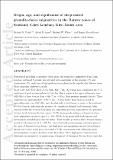Origin, age, and significance of deep-seated granulite-facies migmatites in the Barrow zones of Scotland, Cairn Leuchan, Glen Muick area
Date
10/2018Metadata
Show full item recordAbstract
Petrological modelling of granulite‐facies mafic and semipelitic migmatites from Cairn Leuchan, northeast Scotland, has provided new constraints on the pressure (P) and temperature (T) conditions of high‐grade metamorphism in the type‐locality Barrow zones.Phase diagrams constructed in the Na2O–CaO–K2O–FeO–MgO–Al2O3–SiO2–H2O–TiO2–O2 system have constrained the P–T conditions of peak metamorphism in the Glen Muick region of the upper‐sillimanite zone (Sill+Kfs) to have been at least ~840 ◦C at ~9 kbar (high‐pressure granulite facies). These conditions are approximately ~120 ◦C and ~3 kbar higher than those recorded by lower‐sillimanite zone (Sill+Ms) units located only a few kilometres away to the southeast at Glen Girnock, indicating the presence of a significant thermal and barometric high exposed within the Scottish Dalradian and supporting previous suppositions of a potential tectonic break between the two regions. U–Pb zircon geochronology performed on these mafic migmatites produced ages of c. 540–470 Ma from grains with both igneous and metamorphic morphological characteristics. Their basaltic protoliths likely formed during a period of volcanism dated at ~570 Ma, associated with passive‐margin extension prior to the onset of Iapetus Ocean closure, and high‐grade metamorphism and partial melting is interpreted to have taken place at around 470 Ma, synchronous with sillimanite‐grade metamorphism recorded elsewhere in the Dalradian. These high‐grade Cairn Leuchan lithologies are interpreted as representing a fragment of Grampian Terrane lower crust that was exhumed via displacement along a steeply dipping tectonic discontinuity related to the Portsoy–Duchray Hill Lineament, and are not pre‐Caledonian Mesoproterozoic basement, as suggested by some previous studies. Veins within some mafic migmatites in the Cairn Leuchan area, composed almost entirely (>80%) of garnet, with minor quartz, plagioclase, amphibole, and clinopyroxene, are interconnected with leucosomes and are interpreted to represent former garnet‐bearing melt segregations that have been locally drained of almost all melt. Thus, mafic components of the lower crust, currently underlying relatively lower‐grade metasediments exposed to the southeast, may represent a potential source rock for widely documented, post‐orogenic felsic plutons, sills, and dykes that occur throughout the Grampian Terrane.
Citation
Palin , R M , Sayed , A B , White , R W & Mertz-kraus , R 2018 , ' Origin, age, and significance of deep-seated granulite-facies migmatites in the Barrow zones of Scotland, Cairn Leuchan, Glen Muick area ' , Journal of Metamorphic Geology , vol. 36 , no. 8 , pp. 1071-1096 . https://doi.org/10.1111/jmg.12428
Publication
Journal of Metamorphic Geology
Status
Peer reviewed
ISSN
0263-4929Type
Journal article
Description
Funding for this work was provided by the Johannes-Gutenberg University of Mainz.Collections
Items in the St Andrews Research Repository are protected by copyright, with all rights reserved, unless otherwise indicated.

